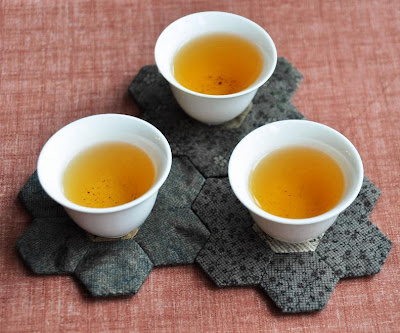Some of my English readers wonder what was I doing in
Brussels, Belgium from May 5 to May 7, 2012. (No, it wasn't a Tea Party in front of the European Parliament to protest Europe's excessive taxation and deficit spending!)
I attended the
TeaWorld Rendez-vous, the first European meeting about
tea. Last fall, in Taiwan, I had met Roland Dacos, the organizer of this event. He wanted to
organize a fair that wasn't purely commercial, but that would emphasize
the cultural aspects of tea. This was a good fit for my blog, I thought,
and accepted his invitation to go to this event. I would animate a booth
and make a lecture on tea storage and improvement. It's this second
part of my lecture that I would like to share with you in this post.
The
calligraphy in the center of my booth caught the attention of these Japanese Sencha-do ladies! On one table, I had Cha Xi, which I used to prepare tea for my guests. On the other table, I brought some of my teas and teaware for display and sale. The weekend was a success. There were so many visitors that I hardly had time to sit down! And despite the jet lag, I felt great talking and drinking tea with fellow tea lovers.
The lecture on 'Conservation and Improvement of tea' happened on Sunday, May 6. (The first part of the conference can be read
here with an automatic translator)
The second part: Tea Improvement
For the improvement of tea, there are many similarities with wine:
- White wines don't age so well, but there are exceptions. The same is true with green teas: most are meant to be drunk quickly, while fresh, but there are also some that can be aged well. Example: Liu An tea or top quality Bi Luo Chun or Longjing.
- Table wines and mediocre wines in general aren't collected or aged. Wine lovers age great wines for special occasions (wedding
anniversaries, the birth of a child, Christmas, the start of
retirement...). It's the grands crus, the wines with the highest quality that are aged. This quality requirement also applies to tea. Improving wine or tea isn't alchemy. It's not turning the bad into good, but the good into better.
- Old wines fetch record sums. So does
old tea. If I mention this, it's not to suggest tea as an investment. (The resale of old tea is more complex due to the lack of labels). If old teas can be worth so much money, it's because they can yield special pleasures. I can testify that I had the opportunity to taste some very old puerhs and Oolongs, and found their tasting sometimes bordering the mystical! Not always, but when it happens, it's an experience that isn't soon forgotten.
A. To select a tea for aging, quality is king.
How do we determine quality in tea?
The longer your pleasure lasts, the more value (and quality) a tea has. The longer the taste lasts in your mouth, the more potential the tea has to age. Aging means a certain loss of strength, so it's necessary that the tea be quite strong when young.
But length of taste isn't the only criteria. The tea should also feel pure, clean and comfortable (inside your mouth and your whole body).
Scents are less important, since they are going to evolve with time. Nevertheless, you probably won't want leaves that carry a bad, artificial or foul smell.
B. What teas or most suitable for aging?
1. Raw/sheng puerh
Raw puerh is most associated with aged tea. This is so much the case that some vendors tell their customers that you have to wait X years before you can start to drink your young puerh. This is false. A good puerh, suitable for aging, will be good to drink now. Another pitfall is due to the boom of puerh production since the 1980s. Before that, puerh was harvested in small quantity from mostly old trees that were growing without much human intervention (fertilizers, pesticides). Such leaves were very natural, clean and strong (= excellent quality for aging). After the 1980s, more and more large puerh plantations have been established. An increase of output has led to a general decrease of quality.
The place where puerh is stored will impact its taste. Even in Taiwan, the same puerh will taste differently depending
how it's stored. Asia, with its humid and high temperatures, is generally regarded as more suitable to store puerh. The dry and cooler regions of Europe (and North America) may not be the best places to store puerh.
2. Roasted Oolongs
The other tea family with good aging potential is Oolong and more specifically roasted Oolong. Charcoal roasting is a process that was perfected to keep the tea fresh on those long ship journeys across oceans to Europe or North America. A good roast dries the leaves, create stronger, sweeter flavors, but also retains the feeling of green freshness of the tea.
Thanks to modern, faster logistics, we can enjoy unroasted Oolongs, but these leaves contain more moisture and aren't suitable for long term storage.
Once an Oolong is well roasted, it doesn't have to be roasted again. (This is something tea stores do with their left overs). It is best kept in a glazed jar (preferably
porcelain), filled completely with tea. This will minimize the air inside the jar.
Oolong prefers a cool and dry environment for its storage. This favors continental Europe and America.
Examples of roasted Oolongs: Hung Shui Oolong, roasted Wu Yi Yan Cha, traditional Oriental Beauty...
Conclusion: The metaphysical pleasure of tasting youth and freshness in an old tea rewards years of aging of good tea. Regular monitoring and tasting along the way also yield a lot of pleasure and understanding about tea.
Good luck!
























































